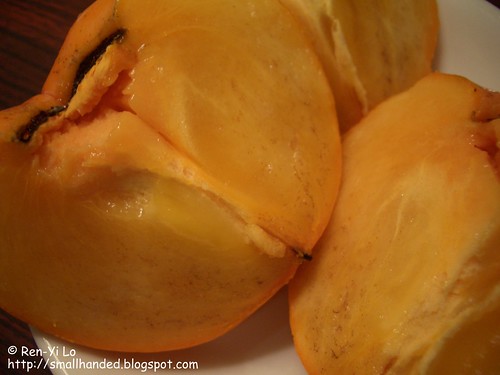For you few & loyal fans out there, we small-handed gals have not dropped off the face of the earth! Quite the contrary, this has been a very busy start of the year. I will be moving soon (yes, yet again *le sigh*) But excitingly, I have found an reasonably-priced apartment and will be sorting, trashing, and packing like a Tazmanian Devil.
The other small-handed girl has been stuck in lab, working like a mad scientist, to produce some data that will hopefully allow her to make her mark in the biology community. ;)
On a blogger's note, I have found a not so painful way to watermark my pictures. So there should be more things uploaded in my flickr stream shortly. Also look out for a new and improved blog page, as my very artsy, desginer brother helps us create our blogger's image.
Monday, January 19, 2009
Friday, January 2, 2009
[Hong Kong] Persimmon, the Orange Tomato Fruit
My parents introduced me to the persimmon when I was very young. We did not have it often, since they were very expensive and hard to find in Europe. I just remembered that I was very confused, because it looked like an orange tomato with some weird leaves that had to be yanked off, and my parents kept calling it an "orange tomato fruit."
Tomatoes were always regarded as vegetables in our household, so why was this a fruit? (Never mind the biologist's argument that tomatoes are fruit for now). So this "sweet vegetable" was a fruit, lacked the fluid, seedy chambers of a tomato, but had a similar skin and flesh texture.
I was re-introduced to this fruit again by a coworker in 2004. She was very generous to share these with me and I was instantly hooked on these "orange tomatoes." Her culture calls it the "Sharon Fruit" and my grandmother calls them shì zi (柿子).
There are two kinds of persimmons: astringent and non-astringent.
Astringent persimmons contain high levels of tannins, which is responsible for the dry, puckering aftertaste when consuming unripe fruit. Therefore, astringent persimmons should not be consumed until they are ripe and soft; they should feel like overripe apricots or peaches. The ripening process is what rids the high levesl of tannins. The most common persimmon is the Japanese persimmon, recognizable by its distinct heart-shape body. Trying to eat them before they are ripe gives off a chalky and displeasing aftertaste and texture in the mouth. I speak from experience ;)
Non-astrigent persimmon (my favorites!) are less fussy about when they are eaten, since they have low levels of tannis. I like them when they are still firm and waxy on the outside, since they are crispy like an apple on the outside, yet fleshy and not mush like pumpkin pulp. However, consuming them while they are over-ripe is also fine. The most common persimmon have no tip like its Japanese cousin; instead it is squat like a beef-steak tomato and often also have the label 'fuyu' when it is sold.
While perusing the grocery stalls in Hong Kong, I could not resist picking up one of these.


We enjoyed this persimmon chilled. And although my parents were hesitant about consuming this persimmon while "unripe," with some coaxing they enjoyed this new way, since the fruit tasted crisp, fresh and light, and was less messy. :)
Today persimmons can be easily found in any major grocery store during the winter months and almost year around at any Asian grocery store. If you have not tried them, you are in for a treat. Let me know what you think!
Tomatoes were always regarded as vegetables in our household, so why was this a fruit? (Never mind the biologist's argument that tomatoes are fruit for now). So this "sweet vegetable" was a fruit, lacked the fluid, seedy chambers of a tomato, but had a similar skin and flesh texture.
I was re-introduced to this fruit again by a coworker in 2004. She was very generous to share these with me and I was instantly hooked on these "orange tomatoes." Her culture calls it the "Sharon Fruit" and my grandmother calls them shì zi (柿子).
There are two kinds of persimmons: astringent and non-astringent.
Astringent persimmons contain high levels of tannins, which is responsible for the dry, puckering aftertaste when consuming unripe fruit. Therefore, astringent persimmons should not be consumed until they are ripe and soft; they should feel like overripe apricots or peaches. The ripening process is what rids the high levesl of tannins. The most common persimmon is the Japanese persimmon, recognizable by its distinct heart-shape body. Trying to eat them before they are ripe gives off a chalky and displeasing aftertaste and texture in the mouth. I speak from experience ;)
Non-astrigent persimmon (my favorites!) are less fussy about when they are eaten, since they have low levels of tannis. I like them when they are still firm and waxy on the outside, since they are crispy like an apple on the outside, yet fleshy and not mush like pumpkin pulp. However, consuming them while they are over-ripe is also fine. The most common persimmon have no tip like its Japanese cousin; instead it is squat like a beef-steak tomato and often also have the label 'fuyu' when it is sold.
While perusing the grocery stalls in Hong Kong, I could not resist picking up one of these.


We enjoyed this persimmon chilled. And although my parents were hesitant about consuming this persimmon while "unripe," with some coaxing they enjoyed this new way, since the fruit tasted crisp, fresh and light, and was less messy. :)
Today persimmons can be easily found in any major grocery store during the winter months and almost year around at any Asian grocery store. If you have not tried them, you are in for a treat. Let me know what you think!
Subscribe to:
Posts (Atom)
